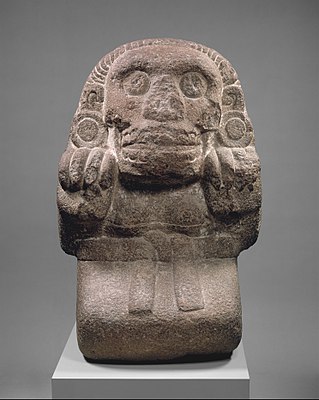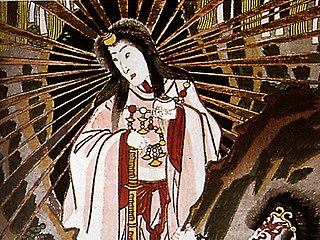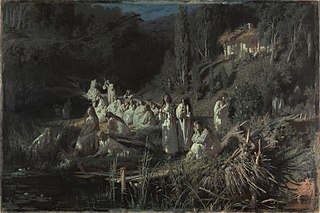Áine is an Irish goddess of summer, wealth, and sovereignty. She is associated with midsummer and the sun, and is sometimes represented by a red mare. She is the daughter of Egobail, the sister of Aillen and/or Fennen, and is claimed as an ancestor by multiple Irish families. As the goddess associated with fertility, she has command over crops and animals and is also associated with agriculture.

In Aztec mythology, the Cihuateteo or "Divine Women", were the spirits of women who died in childbirth. They were likened to the spirits of male warriors who died in violent conflict, because childbirth was conceptually equivalent to battle in Aztec culture. According to tradition, a woman in labor was said to capture the spirit of her newborn child similar to the way a warrior captures his opponent in battle. These spirits are also associated with the west, the place where the sun sets each day.

In European folklore of the medieval and early modern periods, familiars were believed to be supernatural entities, interdimensional beings, or spiritual guardians that would protect or assist witches and cunning folk in their practice of magic, divination, and spiritual insight. According to records of the time, those alleging to have had contact with familiar spirits reported that they could manifest as numerous forms, usually as an animal, but sometimes as a human or humanoid figure, and were described as "clearly defined, three-dimensional... forms, vivid with colour and animated with movement and sound", as opposed to descriptions of ghosts with their "smoky, undefined form[s]".

A haunted house, spook house or ghost house in ghostlore is a house or other building often perceived as being inhabited by disembodied spirits of the deceased who may have been former residents or were otherwise connected with the property. Parapsychologists often attribute haunting to the spirits of the dead who have suffered from violent or tragic events in the building's past such as murder, accidental death, or suicide.

Leshy or Leshi is a tutelary deity of the forest in pagan Slavic mythology. As Leshy rules over the forest and hunting, he may be related to the Slavic god Porewit.

Yūrei are figures in Japanese folklore analogous to the Western concept of ghosts. The name consists of two kanji, 幽 (yū), meaning "faint" or "dim" and 霊 (rei), meaning "soul" or "spirit". Alternative names include Bōrei (亡霊), meaning ruined or departed spirit, Shiryō (死霊), meaning dead spirit, or the more encompassing Yōkai (妖怪) or Obake (お化け). Like their Western counterparts, they are thought to be spirits barred from a peaceful afterlife.

Queen Mab is a fairy referred to in William Shakespeare's play Romeo and Juliet, in which the character Mercutio famously describes her as "the fairies' midwife", a miniature creature who rides her chariot over the bodies of sleeping humans during the nighttime, thus helping them "give birth" to their dreams. Later depictions in other poetry and literature and various guises in drama and cinema have typically portrayed her as the Queen of the Fairies.

In Japanese traditional beliefs and literature, onryō are a type of ghost believed to be capable of causing harm in the world of the living, injuring or killing enemies, or even causing natural disasters to exact vengeance to "redress" the wrongs it received while alive, then taking their spirits from their dying bodies. Onryō are often depicted as wronged women, who are traumatized, envious, disappointed, bitter, or just infuriated by what happened during life and exact revenge in death. These kinds of ghosts appear extremely vengeful, ruthless, heartless, brutal, cruel, deranged, egotistical, selfish, bloodthirsty, and cold-hearted.
Gwyllion or gwyllon is a Welsh word with a wide range of possible meanings including "ghosts, spirits" and "night-wanderers up to no good, outlaws of the wild." Gwyllion is only one of a number of words with these or similar meanings in Welsh. It is a comparatively recent word coined inadvertently in the seventeenth century by the Welsh lexicographer Dr John Davies of Mallwyd.

The Churel, also spelled as Charail, Churreyl, Chudail, Chudel, Chuṛail, Cuḍail or Cuḍel, also known as Petni and Shakchunni, is a mythical or legendary creature resembling a woman, which may be a demoniacal revenant said to occur in South Asia and Southeast Asia, particularly popular in India, Bangladesh, Nepal and Pakistan. The churel is typically described as "the ghost of an unpurified living thing", but because she is often said to latch on to trees, she is also called a tree-spirit. According to some legends, a woman who dies very cruely will come back as a revenant churel for revenge, particularly targeting the males in her family.

In Slavic folklore, the rusalka is a female entity, often malicious toward mankind and frequently associated with water, it has counterparts in other parts of Europe, such as the French Melusine and the Germanic Nixie. Folklorists have proposed a variety of origins for the entity, including that they may originally stem from Slavic paganism, where they may have been seen as benevolent spirits. Rusalki appear in a variety of media in modern popular culture, particularly in Slavic language-speaking countries, where they frequently resemble the concept of the mermaid.

Sheka is a dwarf-like being in the Turkic mythology, that lives in forests or derelict houses. In the legends they tend to appear in comical situations.

A brownie or broonie (Scots), also known as a brùnaidh or gruagach, is a household spirit or hobgoblin from Scottish folklore that is said to come out at night while the owners of the house are asleep and perform various chores and farming tasks. The human owners of the house must leave a bowl of milk or cream or some other offering for the brownie, usually by the hearth. Brownies are described as easily offended and will leave their homes forever if they feel they have been insulted or in any way taken advantage of. Brownies are characteristically mischievous and are often said to punish or pull pranks on lazy servants. If angered, they are sometimes said to turn malicious, like boggarts.

A bhoota is a supernatural creature, usually the ghost of a deceased person, in the popular culture, literature and some ancient texts of the Indian subcontinent. Interpretations of how bhootas come into existence vary by region and community, but they are usually considered to be perturbed and restless due to some factor that prevents them from moving on. This could be a violent death, unsettled matters in their lives, or simply the failure of their survivors to perform proper funerals.
Poludnitsa is a mythical character common to the various Slavic countries of Eastern Europe. She is referred to as Południca in Polish, Полудниця in Ukrainian, Полудница (Poludnitsa) in Serbian, Bulgarian and Russian, Polednice in Czech, Poludnica in Slovak, Připołdnica in Upper Sorbian, and Полознича (Poloznicha) in Komi, Chirtel Ma in Yiddish. The plural form of this word is poludnitsy. Poludnitsa is a noon demon in Slavic mythology. She can be referred to in English as "Lady Midday", "Noonwraith" or "noon witch". She was usually pictured as a young woman dressed in white that roamed field bounds. She assailed folk working at noon, causing heatstrokes and aches in the neck; sometimes she even caused madness.

The Russian folklore, i.e., the folklore of Russian people, takes its roots in the pagan beliefs of ancient Slavs and now is represented in the Russian fairy tales. Epic Russian bylinas are also an important part of Slavic paganism. The oldest bylinas of Kievan cycle were recorded in the Russian North, especially in Karelia, where most of the Finnish national epic Kalevala was recorded as well.

In mythology and folklore, a vengeful ghost or vengeful spirit is said to be the spirit of a dead person who returns from the afterlife to seek revenge for a cruel, unnatural or unjust death. In certain cultures where funeral and burial or cremation ceremonies are important, such vengeful spirits may also be considered as unhappy ghosts of individuals who have not been given a proper funeral.
Feldgeister or Korndämonen are corn spirits in German folklore. Feldgeister are often also wind spirits, causing lightning and rain.
The Buschgroßmutter is a legendary creature from German folklore, especially found in folktales from the regions Thuringia, Saxony, former German-speaking Silesia and the former German-speaking parts of Bohemia. She is called various regional names such as Pusch-Grohla and Buschmutter in Silesia, 's Buschkathel and Buschweibchen in Bohemia, Buschweiblein and Buschweibel in Silesia again. Buschweibchen, Buschweiblein, and Buschweibel all mean "shrub woman", with Weibchen, Weiblein or Weibel being the diminutive of Weib, "woman".

In Slavic paganism there are a variety of female tutelary spirits associated with water. They have been compared to the Greek Nymphs, and they may be either white (beneficent) or black (maleficent). They may be called Navki, Rusalki, and Vily.















